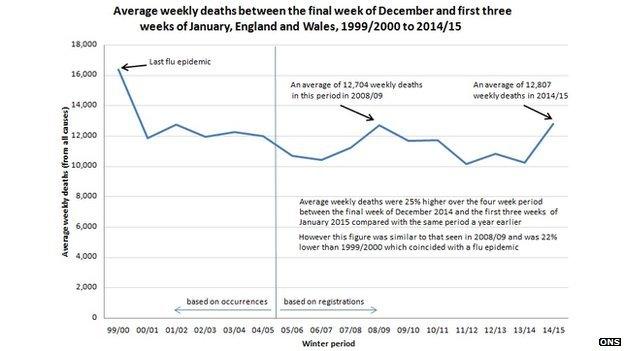Headline numbers: Why are winter death rates so high?
- Published

There has been a considerable increase in the numbers of people dying in England and Wales so far this year.
The Office for National Statistics (ONS) that in the first six weeks of 2015, just over 82,000 deaths were registered, which is 23% higher than the average from the previous five years.
The ONS recently the graph above, which compares the last week in December and first three weeks in January for the last 16 years.
First of all, while we are currently well above the average for the past five years, we are at about the same level as we were in winter 2008-09.
Secondly, the spike for this year is exaggerated somewhat by last year, when there was the smallest number of Excess Winter Deaths since records began in 1950.
Excess Winter Deaths are the number of people whose deaths were registered between December and March, compared with the numbers for the previous four months and the following four months.
Thirdly, while the figures are high by recent standards, they are dwarfed by the levels in 1999-2000, which was the last year classified as a flu epidemic. An epidemic year is one in which more than 200 people per 100,000 go to see their GPs with flu-like symptoms.
We know that flu has played a part in this year's high numbers.
Public Health England's analysis that the high number of deaths, "coincides with circulating influenza and cold snaps", with the over-65s particularly hard hit by the strains of the virus spreading this year.
It also appears that this winter's flu vaccine has been less effective than usual, which is suspected to be contributing.
But as for cold snaps, the temperature this winter was a bit warmer than average in December, close to average in January and only slightly below average in February, according to this from the Met Office on Wednesday.
It's possible that deaths have been relatively low for five years and coincidentally have been a bit higher this year.
We should get a better idea when the breakdown of causes of death are published later in the year.